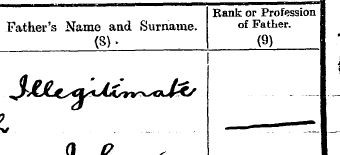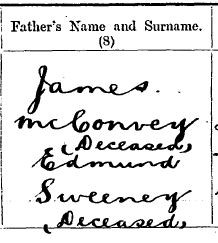“You say it best, when you say nothing at all…” So the song goes and, along with Rocky Racoon, it’s one of the songs that springs to mind when I think of genealogical records.
One of the things that looking at vast numbers of a given record set teaches you, is that sometimes absence says an awful lot.
Irish civil records, the bulk of which have been made available on Irish Genealogy in the past year, are an excellent example of this. The certificates themselves contain a wealth of information of use to the genealogist, but the forms themselves are prescriptive. And in the hands of a ‘diligent’ civil servant (registrar) this can mean often columns are left blank for one reason or another.
The most obvious, and numerous, example of this is the registration of births for children born out of wedlock. In the majority, but certainly not all, of these instances the column for father’s name is left blank, and only details of the mother are recorded. We can surmise that the dictate given to registrars was that there were not to record the father name and details, unless the couple were married.
However, like in any organisation there are often rogue agents, who take it upon themselves to record what they believe to be the correct information, no matter what ‘The Man’ dictates. Therefore, you do get anomalies whereby both parents are recorded on a birth certificate, however where the word ‘formerly’ is recorded under the name of the mother, this is often struck-through and her maiden name recorded in the column (without a married name).
Where these absences of information can be instructive are on records such as marriage certificates. Marriage certificates are supposed to record the fathers’ name and occupation for both parties. However, occasionally we come across certificates where these fields are left blank or have a line through them. This can be indicative of the individual marrying having been born out of wedlock. Only once have I come across an instance like the one below, where the explanation was actually spelled out;

Another example of this, is where a fathers’ name is recorded, but no occupation is provided in column 9. This can often be an indication that the father is deceased. Whether or not a father is deceased at time of marriage is something which is occasionally annotated by the registrar, as in the case below;

Often trying to determine what the person creating, or submitting information for, a record is trying to tell us by the information they omit, can offer insights into additional information about those involved.
By Researcher Stephen Peirce.